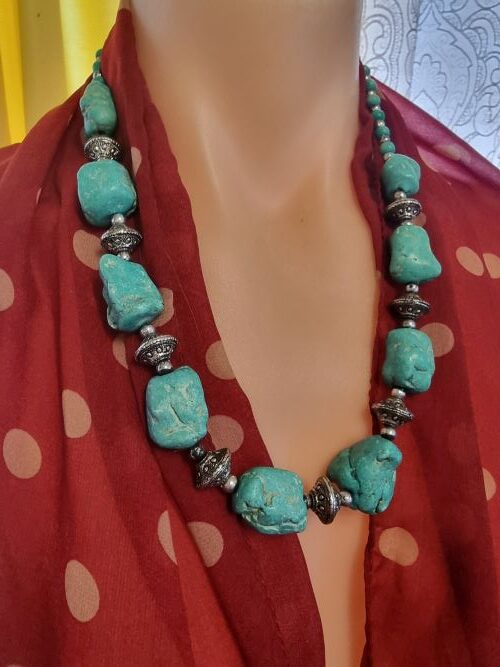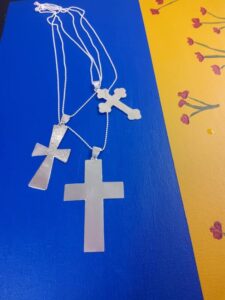Beads have been circa since humankind could work tools at the beginning of the Stone Age 2.5 million years ago. People would bore holes into found material, such as coral, shells, amber, and stones. Deemed a precious trade commodity, used like money today for exchanging services and other items of everyday needs.
When were beads invented?
Beads have long been made in many societies from all around the globe. Some African tribes used Amber, fossilized tree resins for making large trade beads. Used as a form of currency to buy other needs such as food. These beads have been found in hidden treasures in Northern Africa, including Morocco, dating back as far as the Stone Age 15000 years ago.
The Ancient Egyptians were recognized for forming glass beads. They used fireproof rods to wind the the molten glass around, forming shaped colored glass beads. Some glass beads have been found dating back to 3500 BC. The Romans also made glass beads. In fact, the Italians also had glass workshops, also known as Venetian glass studios.
The Indigenous Aboriginals and Torres Strait Islander people were known for making beads from the hard seeds of certain trees like the She-Oak Casuarina and other hardwoods. They also used bone, teeth, and shells to make unique beads.
Archaeologists have found beads made by the Chinese around 2000 years ago, mainly glass and ceramic.
What is the reason for beads?
As mentioned many beads were produced to trade and barter for other commodities and services. But also beads were and are still now used for prayer and contemplation. The most commonly known prayer beads are the Rosary Beads which are used by Christian Nuns and Priests, who hold each bead reciting the Hail Mary Prayers.
Buddhist and Hindu Monks also use beads strung in a necklace, using 108 beads, also known as the Mala. Again holding each bead in prayer and or singing a mantra.
The Chinese are well-known for using ceramic, porcelain blue, and white beads for good luck and Feng Shi. They still produce hanging beaded chime hangers and mobiles with beads, to position in the money far left corner of your home.
What can beads be made of?
China would probably be the best source of ceramic and porcelain beads. Ceramic is clay from Earth, which is coated with a glaze and then fired in a kiln. Ceramic beads can be bright colors, and odd or symmetrical shaped forms.
Glass beads are made from sand, or better known as silica. This silica is melted in a crucible to form molten glass. The molten glass is poured into rod, or sheet molds. Then the glass rods are heated in a flame and molded around fireproof rods.
Bone beads are made from animal bone that has been dried and sometimes bleached. Teeth beads a are drilled teeth from animals like sharks, crocodiles, or other land animals. (Please note that some animals are protected, and it is restricted or illegal to hunt for them today in the 21st century.)
Amber beads are better known as fossilized tree resin or sap. This special sap is collected a lot from the Baltic Sea and it is found washed up on beaches. It is polished smooth and drilled to form uniquely shaped beads. Amber can be found in the common yellow, brown, or milky yellow. It is also found as green and blue as the rare specimens. Unusual insects can also be trapped in the Amber while it is in a liquid state. The sap hardens over time. Often Amber is millions of years old.
Gemstones, precious and semi-precious are stones found on Earth. They can be varying colors ranging from Sapphire blue, Emerald green, yellow Citrine, and purple Amethyst, the list is quite extensive. The gemstones are tumbled in a machine to smooth and polish rough edges, they are sometimes cut and faceted by lapidaries and then drilled with precision to make the beads.
Coral is no longer made into beads as it is considered an endangered species. Yes, Coral is classified as an ecosystem of animals, better known as Polyps. Red coral was traditionally used in making beaded necklaces, and earrings for the high-status populous, such as Queens. It was found in the Coral Reefs around the world, which is now largely instinctive because of human habitats and farming practices, which caused the bleaching of the reefs to die. Also, climate rise has destroyed a lot of coral from growing. The Great Barrier Reef in the Eastern Queensland State of Australia is probably the last known surviving coral Reef. (Please note it is illegal to collect coral from even the beach.)
Hardwood seeds from trees are often collected, dried, and coated with a varnish, then drilling a hole makes the beads.
How are beads made?
There are many ways that a bead can be made which include traditional techniques such as flamework, drilling, casting, molding, carving and free formation naturally found.
You can use glass rods and under a flame melt the glass spinning it around fireproof turq mandrels. This technique takes practice to get uniform round glass beads. Other shapes including figurines can be achieved this way.
Using an electric handheld drill, and holding the seed, gemstone, bone or pearls in a vice. You can bore holes evenly and with patients beads are produced.
Casting involves melting silver or gold in a crucible with a very hot concentrated flame and then quickly pouring it into wax or cast iron molds.
Silver, gold, and copper can be cut into shapes where they are soldered and shaped or domed into beads. Bone can be carved using blades and chisels to shape beads.
You can be lucky enough to find free-formed shells or rocks that have a hole in them from the forces of mother nature such as moving water, these can be used as beads too.
Conclusion
The art of beads and beading is a very intricate and calming practice. While the tradition goes on in some cultures around the world, there is always something new to be discovered with the many ways a bead can be made. Beads made of cloth (felt) and even paper, can be a fun way to explore beading.
Beads have been a very essential part of human evolution and many people find it a very therapeutic way to relax when designing and producing beads.
At Silverflamze we aim to provide a massive selection of antique beaded jewelry along with modern bead designs in a range of necklaces, anklets, bracelets, and beaded earrings. We also will be showcasing a large selection of beads single or in packs for you to design and produce your own unique ideas of jewelry.
I have been passionate about everything beads since a child and it was something that my mother Eileen would get me crafting with beads to help with restlessness. As soon as I embraced the art of beading, I found instant calmness and relaxation. Then off to the local markets to sell my designs!
If there is anything in particular that you would like me to find or help with regarding all things beads. Let me know by sending me an email or leave a message here in the comments of this blog and I will for sure get in touch with you asap.
Many thanks for reading.
Kind regards
Erica~ The jewelry designer producing heirlooms for future generations!





Hello Erica.
I found this article really interesting as I have friends back home in Ontario, Canada, who make most of all their own jewelry and have a precious metal and stone market. I didn’t realize there were many types of beads, where they originated from, and the amount of work that goes into making something from them.
Where we are in Mexico, I see many shops that sell jewelry made from beads.
I agree about the therapeutic aspect of relaxing when designing and producing beads, as they too have mentioned this to me.
Thanks for sharing. I will definitely check out your online shop.
Hello Mary Ann,
Thanks very much for your comments I appreciate hearing your story. Yes for sure Mexico has a long history with beads also, in particular silver and semi precious gems. I think all around the world, beads were common place for the many reasons of decoration, trading and bartering.
I am glad you found my article interesting thanks again.
Kind regards
Erica
My fascination with beads started after seeing a colleague wearing a beautiful necklace made of beads. She said it’s part of her culture and she is proud to wear it as an essential part of her wardrobe. I forgot to ask about her cultural background but by her physical looks and features, she’s probably Chinese.
Anyway, I then started reading more about this beautiful piece of art which got me landing on your site. Thank you for sharing about the origin of beads, why they are made, and the materials used to make them. I wonder if the cost depends on the kinds of materials they are made of and if all these materials can be used in combination to make a necklace or bracelet.
Hello Alice,
Thanks very much for your comments on my blog. Thanks for bringing to attention the costs of beads. Yes the cost can vary depending on the materials, absolutely.
Beads that are no longer harvested can be very expensive especially coral. Some semi precious gemstones like turquoise, sapphires and emeralds or rubies are also rated high price.
I will endeavor to add to this blog more details around the cost per gram!
Kind regards
Erica
Hello, Erica Being a practising Catholic, I appreciate this a lot; I’ve purchased rosaries made of many materials. Because of their beauty, I gifted some to loved ones, and I’ve also found that using beads as a kind of meditation has helped me immensely. Thank you for bringing back happy memories associated with my rosaries.
Hello Okiwelu,
Thanks so much for your kind comments here on my blog about the history of beads. It is a lovely tradition using the Rosary Beads that is about meditation and contemplation, often bringing peace to the holder.
I appreciate your thoughts shared thanks again,
Kind regards
Erica
I am from New Orleans and for Mardi Gras they throw people beads, amongst other items and prizes. I wonder if there is some deep meaning behind it. I’m sure that there is. What is your thoughts on that?
also, I know a lady who makes and sells beaded items. She uses different types of beads, all and sizes. I think it’s very interested. Good post!
Hello KD, wow thanks for sharing that the event Mardi Gras they throw beads on them, very interesting to know that thanks for sharing. I imagine it will be the celebration and they are choosing a bead to throw. However it is the first time I heard this, thanks so much for sharing with me, I shall investigate it further.
Kind regards
Erica
It’s truly fascinating to delve into the rich history of beads and how they have evolved over time. I enjoyed the comprehensive look at the various materials and techniques used to create beads across different cultures and eras, in particular, your personal connection to beads and how they’ve brought you calmness and creativity since childhood. Your commitment to preserving and sharing the art of beading is evident, and I’m excited to explore your collection of antique and modern bead designs. Thank you for sharing this insightful journey through the world of beads!
Hello Aly,
Thanks so much for your thoughts on my article the history of beads. I appreciate that you enjoyed reading it and that you can see how it brings calmness to my life.
In fact I think that beading can be very useful for mindfullness and contemplation for anyone!
Thanks for taking a look at my collection, I have a lot of jewellery that is still waiting to be listed on my website, so if you are looking for a particular bead, be sure to reach out to me,
Kind regards
Erica
Hi Erica,
What a fascinating article on the history and variety of beads! I had no idea there was such depth and history behind each type of bead material, from ancient coral and bone to modern glass and ceramic. It’s incredible to learn how beads have been used across different cultures and times for trade, decoration, and even meditation. I’m curious, with the decline in natural resources like coral, how do you see the future of bead-making evolving? Do you think new materials will emerge, or will there be a shift back to traditional ones?
Thanks for sharing this comprehensive guide; it’s opened my eyes to the art and significance of beads!
Cheers,
Dean
Hello Dean,
Thanks heaps for reading my blog on one of my biggest passions being the history of beads. I truly think my fascination with beads started when I owned The Silver Shop in Townsville city, Queensland Australia during 1998.
It was when we imported some Amber resin trade bead necklaces that came from Africa, this was a wonderful experience feeling the energies that resonated from those necklaces. They called to me a sense of heritage and nobleness. The trade Amber beads were used for decades in Africa and are highly prized in the possession of them.
One can not truly comprehend the qualities of rare beads unless you have held them in your hands, they actually do resonate vibes and the characters of each bead vibrate differently depending on the artist that created them and the region of the raw materials.
I do see the decline in semi precious beads very rapidly in the last century, especially the authentic natural sources of gems, and as I mentioned rare Corals.
I have seen the rise of glass, but in saying this, even glass is becoming rare as the decline is sand, from all the sand mining for construction.
Plastics are very popular these days, but even as fossil fuels are decreasing, plastic will too also one day be rare, believe it or not.
I am still researching myself on new materials to continue the art of bead production and I will keep Silverflamze updated with my new innovations and ideas for the future of beads.
Once again Dean, thanks for sharing your thoughts I appreciate it very much.
Kind regards
Erica